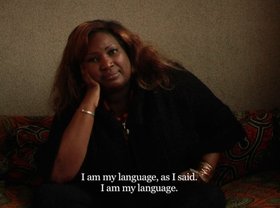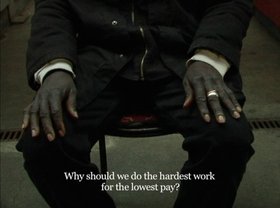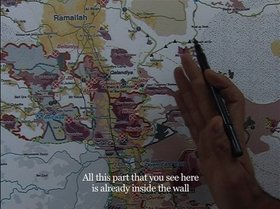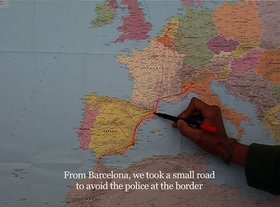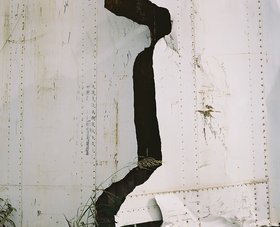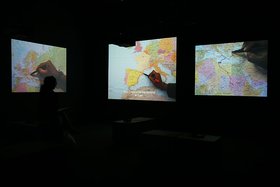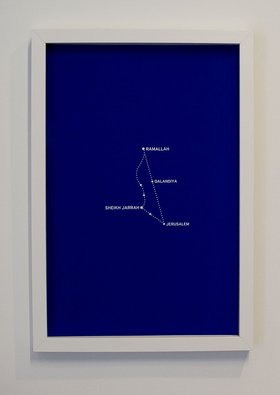Interviews
Absorbing Displacement
Bouchra Khalili in Conversation with Dorothea Schoene
Dorothea Schoene speaks to Moroccan-French artist Bouchra Khalili about her interest in dialect, focusing on her recent video installation Speeches (2012). The work finds invited exiled people re-articulating famous writings and speeches by authors such as Malcolm X, Abdelkrim El Khattabi, Mahmoud Darwish and Édouard Glissant into their mother tongues. Khalili's interview explores the tension between oral and written communication, and unpacks the artist's interest in studying the language used by different ethnic minorities. These issues raise questions that explore the dichotomies between local histories and grand narratives, and explore how an author's voice can be transposed through the physical act of disembodiment.
Dorothea Schoene: Your work Speeches (2012) has just been shown at La Triennale in Paris, curated by Okwui Enwezor. It is a video installation built around a series of five videos. In this project, you have people with a migratory background recounting famous writings and speeches by authors such as Malcolm X, Abdelkrim El Khattabi and Édouard Glissant. The narrators translated the texts into their mother tongues, learnt them by heart and then re-narrated them, to the camera, in their own tongue.
How did you conceive of the project?
Bouchra Khalili: Dialects and languages - particularly the languages of minorities - have played a prominent role in my work from the very beginning. Probably because one of my two mother tongues - Moroccan Arabic - which is called 'Darija' in Arabic, and that literally means 'dialect', is a subtle and complex mixture of Arabic, Berber language, French, and even sometimes Spanish. The ability of Moroccan dialect to appropriate and transform words from other languages is fascinating. When one uses sound and when one records words, language becomes fundamental; it reveals anthropological and social realities, as well as a part of the colonial history, and one can still hear this in our language. But 'Darija' is also a language that is mostly used for oral communication. Rarely written, it constantly changes and evolves. It is somehow a 'creole', as Édouard Glissant defines it: a combination of 'heterogeneous elements that are put into contact, valorise each other, and there is no degradation or diminishing of the being, in the contact and mixing'.[1]
Also the fact is that I have always been fascinated by Pier Paolo Pasolini's semiotics. Pasolini defines cinema as the 'written language of reality'.[2] Yet the beauty of Pasolini's idea is that the reality speaks its own language, and that cinema is a language because it records the language of reality. In my work - and even more precisely, in Speeches - the language of reality is the language that you speak, it is your own language. That's why the languages one hears in Speeches are mostly oral, some are even unwritten dialects, spanning from Malinké from Mali to Moroccan Arabic, Kabyle from Algeria to Dari from Afghanistan, and Wolof from Senegal.
For Speeches, my main idea was then to displace relevant essays and speeches by Aimé Césaire, Malcolm X and Mahmoud Darwish among others, into reality itself through a translation process, and then literally 'implant' them into everyday life, experimenting how much they are still relevant in a different context in terms of language, identity, time and space.
DS: How did you collaborate with the participants in the project?
BK: It's such a complex process that it's impossible to describe it. I'm often asked how I meet the participants in my projects. It's a question I don't have a simple answer to, mostly because it's all mixed with life. I would not say that I find the subjects who participate in my projects but rather that I meet them and sometimes they find me, rather than I find them. The unexpected is a large part of the process. For example, there is no casting: I never start working on a project with the idea that I must meet an Algerian woman, or a Malian man. From the moment when the encounter occurs, we have a lot of conversations that are a way to learn how to speak to each other. This is an approach I have developed throughout the years to avoid pathos and sentimentality. For Speeches, it was a particularly collaborative process, which was based on proposing a selection of texts and essays to the participants, inviting each of them to choose one of those texts, then working together on literally 'editing' the text. From there, we worked together on the translation process and finally I invited them to choose the location where they wanted to be filmed. All the videos were filmed in a location that belongs to their daily life, mostly at home or at work. I did not want to work with actors; it would not have allowed this peculiar process of interaction between the texts and the everyday life. That's also why I wanted the participants to memorise the texts, rather than read them. Through memorisation, a subtle phenomenon of 'digestion' could occur. They literally 'digested' the texts with their own mother tongues, making those words written by Glissant, Malcolm X or Mahmoud Darwish, become their own.
DS: Did you get feedback on the choices of texts you presented?
BK: I actually got a lot of feedback on the texts. I was very lucky, because all my favourite texts were chosen. Each participant told me that they chose their text because they found them relevant in regard to their own thoughts and views. We had very long and fascinating conversations during the translation process, around very specific words - like for example 'poet', which could not be literally translated into Wolof. We were naturally conducted to form a kind of community of 'dialects and unwritten language' speakers, dealing with powerful texts and thoughts, trying to 'creolise' them. We also frequently discussed the question of the transcription; for Malinké for example, we used a phonetic transcription in Latin characters.
DS: The issue of languages and translation is also prominent in The Mapping Journey Project (2008-2011). Here you had people recounting their routes of migration. The videos show a map and their hand with a pen, drawing their routes of migration whilst telling their personal stories of how they went to each place. In that body of work, the device is largely based on off-screen elements combined with oral narratives.
BK: I built the device of The Mapping Journey Project at the very beginning, before filming anything. But despite the minimalistic aspect of the device, it is inspired by a cinematic process based on the interrelation between on-screen and off-screen spaces, which allows both a metonymic and deictic visual approach, suggesting a reflection on the ability of human experiences and clandestine existences to generate an alternative geography - a geography of resistance. I was interested in confronting the most normative drawing that exists - a map - with most singular situations and experiences.
But in this work, the peculiar aspects of word, speech and language become an imaginary dimension of the image, because through the narrative and the way it is told, the viewer is led to mentally reconstruct the whole journeys, revealing a form of fictional dimension of the project, even though all the trajectories are absolutely real.
DS: For a while now, there has been a broad discourse on social hierarchy being constituted through language, for example, the fact that Arabic only exists as a written form of High Arabic, but not really in local dialects. Similarly the debate over colonial languages, such as French in Northern Africa, raises issues of hierarchy. Most of what the western world considers the canon of cultural manifestos is not translated into a number of languages. In Speeches you are dealing with people who are under-represented, in the context of what we consider a canonised western culture.
BK: Throughout the years English has become a kind of universal language, due to economic globalisation, which of course also carries a cultural globalisation. But paradoxically, more and more, there is an intensive movement of 'creolisation' that carries new identities; identities 'that would not be the projection of a unique and sectarian root, but of what we call a rhizome, a root with a multiplicity of extensions in all directions'[3], to quote Édouard Glissant again. This can be seen in Morocco, where a generation of young writers, artists, musicians, and journalists explore our dialect not only as an oral language, but paradoxically as the translation of our own modernity that we invent, beyond western models. At the same time, this generation is also multilingual, easily and happily spanning from one language to another, one culture to another - all facts related to this very specific modernity.
In my case, focusing on minorities' languages and speeches is a concrete manner to explore empowerment processes. One Speeches video summarises this approach. It quotes a text by Mahmoud Darwish, which literally says: 'I am my own language'[4], and this is said by Seynabou, a young Senegalese woman, whose mother tongue is Wolof. It's a very powerful statement that highlights how the language issue embodies the complexities of identity. Darwish wrote those words almost 20 years ago. At that time, he was an exiled Palestinian poet. But because those words are told today by a Senegalese woman on her balcony in a building situated in a neighbourhood on the outskirts of Paris in 2012, it acquires a new life, a new meaning, as well as a new poetic and political dimension.
DS: At first glance, one could say that your work would lead the viewer to issues of migration and nomadism, while you're obviously dealing with wider issues.
BK: I think this categorisation rarely allows one to take into consideration how complex those issues are. That's why I do not consider my work to focus on migration or identity, but more precisely on clandestine and minorities' existences, experiences, discourses and speeches carried by those who live them, and situated at the social, economical, and political peripheries of society. I would then say that if I'm interested in migratory roads, clandestine and minorities' existences it is - to quote Edward Saïd - because 'exile, immigration and the crossing of boundaries are experiences that can provide us with new narrative forms and other ways of telling'.[5]
All this is strongly related to aesthetic issues that I aim to develop: how to produce an image of what is situated on the edge of the visible? How to recount human experiences? What is the status of speech and language in relation to these issues? It is a material of reflections, including on the interrelation of art and reality.
DS: There has been a whole discourse on what exile is and whether or not one can actually escape it. The people you deal with and the topics you address are strongly linked to the experience of exile. There seems to be a certain inability to escape exile in some parts of The Mapping Journey, which you document. Or would that be a misinterpretation of the piece?
BK: To me, that would be a misinterpretation because the participants in The Mapping Journey Project are above all resistants. They are forced into clandestinity, but at the same time, they invent strategies of resistance by inventing roads that do not exist on any maps. It is then more a counter-geography and a counter-cartography that emerges, not traced by arbitrary political powers but human existences, human experiences, oration and ultimately empowerment.
DS: About four years ago, you had a solo show in Marseille entitled Storytellers, which was a title given in obvious contradiction to what you showed and what you had in mind - because a 'storyteller', by definition, could also narrate something fictional. Can you elaborate a little more on this? Where do you draw the line between fact and fiction?
BK: I decided to choose Storytellers as a title because it relates to the notion of storytelling in its original meaning, as the tradition of oral narratives, which all human cultures have in common, a tradition made to share and communicate experiences. Oral tradition and storytelling is a very powerful tradition in Morocco. But I also chose that title in opposition to the concept of 'storytelling' in mass media and to its performative and efficient dimension - since every one of my 'storytellers' are exactly those whose words would usually have no public existence. All my videos aim to show that strange moment when the most peculiar trajectory becomes universal, because I do not work with testimonies, but with experiences that become narratives.
DS: Would you say narratives or stories?
BK: Narratives, because the trajectories told in my videos are the result of a process of long conversations in which I situate myself in both situations of precise talking and attentive listening. What I am interested in is the moment when those whom I am interviewing and listening to begin to answer back to me, to themselves, but also to people in general - the public. Thus, at this moment, their words become a 'public speech'.
DS: In a very different series called Wet Feet (2012) you depict objects that refugees from Cuba and the Caribbean used to flee from their home countries to the US - things like containers, boats or floats. You use here the artistic tool of the 'blind spot' in photography, where you exclude the protagonist and leave it up to the viewer to decide whether what you are showing is fact or fiction. The viewer must also decide where to locate the work, geographically. Did you intend this kind of perception? Do you provide further explanations for your images through text labels, or do you invite the viewer to come up with their own interpretation of the piece?
BK: The issue of invisibility, the dialectical relationship between the hidden and the revealed, has always been at the heart of my practice. It is related to what André Bazin - the French film theorist - called 'the immanent ambiguity of reality'.[6]
Wet Feet articulates both a metonymic and a metaphorical layer: working on very specific objects as traces of those clandestine journeys, but also as a metaphor of the ineluctable failure of the so-called 'American Dream' as experienced by a majority of immigrants. This twofold approach can be seen in my videos as well. For example, I believe that sound is part of the image; that sound is an image. It is related to a conception of editing in which the interval, as Dziga Vertov defined it, is the site of the image. In my work, the site of this interval is in the interrelation between the image and the sound, which is not a voice-over, but a dimension of the image. From there, the viewer's point of view becomes fundamental, because he or she is invited to articulate what is seen, what is heard, what is imagined and what is pictured. Then this interval also becomes the site of the viewer, a site from where the piece can be entered.
DS: Do you consciously draw a line under how much information you supply? Where and when do you leave it up to the viewer to figure things out or imagine a context - how does this vary from piece to piece? Obviously for Speeches, you had a very clear identification of your protagonists; but are there pieces where you keep a very distinct anonymity as part of the actual artwork?
BK: With The Straight Stories Project (2006-2008), Circle Line (2007), or The Mapping Journey Project, I am often asked if I do not film faces in order to protect the anonymity of the persons. But even with my early works, even before these questions started to be clearly articulated, there were no faces. There was already an absence of representation. I prefer to work more on the reverse side of things: on this collision of closeness and distance, which is part of this concept of 'interval'. The invisible can be an image too, and from then it also becomes a surface of projection. In Speeches, the identification process was at the heart of the project itself, precisely because a Malian man based in Paris literally embodies Malcolm X's words; a Kabyle woman embodies Édouard Glissant's words; a Moroccan woman embodies Aimé Césaire's words. So from there - because languages, words, and speeches can also embody the identity - Anzoumane is Malcolm X, Naïma is Édouard Glissant and Naoual is Aimé Césaire. Yet this process of identification goes even further than that, to the point of a gender shift, because in this video series, four women literally endorse male identities, words, and thoughts.
DS: But when you conceive a project, do you have a certain aesthetic or idea that you follow or want to see fulfilled? Or is your framework more technical or - in the case of Speeches - a text you provide?
BK: If you look at The Mapping Project, the device is similar for all of the pieces, however, sometimes the map and in all cases the scale, was changed. The scale responds to the scale of the journey. It becomes obvious when one looks at the installation in an exhibition space, which reproduces this idea of scale both in terms of space and time: the size and height of the projections are different for each video, as well as the interval between them. Then, approaching the exhibition space as if it was an editing room, the installation is then literally edited.
In Speeches, it was also a pre-determining device: I knew that I would film it in maximum six shots, introducing the context, the environment, the location, the narrator, the text, and the language. In those first shots, there's no human figure. Then a human figure appears. It was also a way for me to invite the face as a visual form to enter into my work both in terms of aesthetics and ethics. Then each shot gets closer and closer to the speaker. In between the shots, I used intervals - black screens - that refer to the ellipses produced by the editing process of the texts. When you look at the videos, you get the feeling that each text is all one piece, but in reality they were literally edited, as the videos are edited. Then, from the very beginning of the project, there was a strong interaction between the texts that becomes sound and languages, the visual approach and the editing.
DS: In your earlier work Circle Line (2007) you seem to have a rather different aesthetic.
BK: Not really. If one looks at this video installation from another perspective, one can see that just like in Wet Feet or in Anya (a single channel video I made in 2008), we are dealing with abandoned, deserted spaces, emptied of human life. There is a conceptual connection linking all of my work: it is still this idea that the invisible is an image, that sound is an image. In Circle Line, the scrolling subtitles are a sound - a 'silent sound' - playing at an imaginary and mental level. Many of my videos also refer to the sea as metaphor and metonymy, of a passing space, a space that has no landmarks, a liquid labyrinth dedicated to drift and ultimately a metaphor of exile. But there is also this political dimension to the sea, which is more obvious to certain parts of the globe - it is also a cemetery containing the bodies of those who tried to cross it illegally: in the Strait of Gibraltar, off the Sicilian coast for example, also off Malta, off Greece on the borders with Turkey and in the Atlantic on the borders between the Caribbean and the United States. This also relates to what I attempt with The Constellations (2011), which are not videos or photographs but a series of eight silkscreen prints. I aimed to produce an ambiguous space that refers both to the sea and the sky, blurring the limits between them, as well as blurring the limit between borders: literally erasing them, by translating the drawings of clandestine journeys into constellations of stars.
Bouchra Khalili is a Moroccan-French visual artist, born in Casablanca, Morocco, and currently based between Berlin and Paris. Her work in video, installation, photography, and prints combines a conceptual approach with a documentary practice to explore issues of nomadism and clandestine existences, articulating language, subjectivity, minority discourse and speech, and investigating the interrelationships between contemporary migrations and colonial history, physical and imaginary geography. Khalili's work has been extensively exhibited around the world, including recently at La Triennale (Palais de Tokyo, Paris, 2012); The 18th Biennale of Sydney (2012); MoMa (Mapping Subjectivity, 2011); The 10th Sharjah Biennale (2011), You have been there (Marian Goodman Gallery, New York/Paris, 2011), among others. Recent solo exhibitions include Wet Feet and more, Galerie Polaris, Paris (September 2012); Wet Feet, Tarragona Art Centre, Spain (May 2012), and The Mapping Journey Project, Campagne Première gallery, Berlin (April 2012). Khalili is a founder member of La Cinémathèque de Tanger, an artist-run non-for-profit organisation based in Tangiers, Morocco, for which she has curated numerous film programmes, including recently a 'carte blanche' at Galerie Nationale du Jeu de Paume, Paris (September 2012). Khalili is the recipient of the 2012 Daad-Artists in Berlin award, and the Vera List Center Fellowship Program (The New School, New York).
[1] Glissant, Édouard Caribbean Discourse: Selected Essays, Charlottesville: University of Virginia Press (1991), p. 140 and 561, see also: Ulf Hannerz,'The World in Creolisation', Africa 57 (4) (1987), pp. 546-559.
[2] Pasolini, Pier Paolo, 'The Written Language of Reality', in Heretical Empiricism, Washington DC: New Academia Publishing, LLC (2005).
[3] Glissant, Édouard, 'Creolisation in the making of the Americas', Race, Discourse, and the Origin of the Americas, eds V.L Hyatt, R. Nettleford, Washington: Smithsonian Press (1995), p.271.
[4] Darwish, Mahmoud, 'A Rhyme for the Odes', Unfortunately, It Was Paradise, Berkeley: University of California Press (2003).
[5] Saïd, Edward, Reflections on exile and other essays, Cambridge, MA: Harvard University Press (2002).
[6] Bazin, André, What is cinema?, Berkeley: University of California Press (2004).

